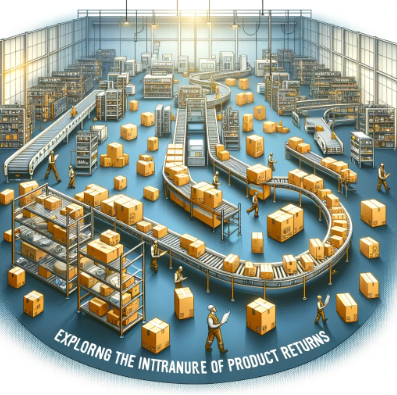RETURNS UNVEILED - Navigating the Intricate World of Product Returns
When you decide those online-bought sweatpants aren't the perfect fit, you trigger a vast and intricate system that manages the fate of unwanted products. This behind-the-scenes process involves a multitude of players—transporters, warehousers, liquidators, recyclers, and resellers—all working to handle the millions of returned products each year. In the heart of this system is Inmar Intelligence's returns-processing center in Breinigsville, Pennsylvania, where material handlers like Michael play a crucial role. Inmar is a returns liquidator, managing the products that consumers no longer want on behalf of various retailers. Despite the integration of complex machinery and data analysis, the more than 40 million annual returned products still require human assessment.
The returns industry, known as reverse logistics, has burgeoned into a global business, valued at nearly $1 trillion in 2022. With online shopping driving return rates to 20-30% of all purchases, third-party facilities like Inmar have become pivotal in handling the overwhelming volume of returns. Inmar claims to be the largest returns liquidator in North America, processing half a billion returned goods annually across 17 facilities.
The Breinigsville facility operates as a hub, processing over 100,000 consumer goods daily for various retailers, from e-commerce giants to clothing brands. The return journey involves meticulous inspection, with material handlers determining whether items go back to retailers, get destroyed, or undergo other outcomes.
Reverse logistics is a necessary but often overlooked aspect of the retail industry. While behemoths like Amazon and Walmart manage their returns efficiently, many other retailers lack the infrastructure to handle the complexities of evaluating and processing returned products. Inmar's expertise, massive scale, and data-analysis capabilities fill this gap.
During a visit to the facility, the author observed the intricate processes, including the evaluation of returned products in different work areas. The fate of each product depends on various factors, including its condition, original packaging, and the retailer's contract with Inmar.
The returns journey doesn't end at the facility; it extends to the final destination of each product. Brands that sell directly to consumers reclaim over 90% of their returns on average, while multibrand retailers struggle to achieve similar rates due to logistical complexities.
Inmar emphasizes the importance of confidentiality, as its clients have agreements preventing the disclosure of the companies it serves. Retailers maintain a delicate relationship with reverse logistics, rarely discussing the system publicly. Consumerism's evolving abstraction layers, from department stores to online shopping, have led to a disconnect between purchase and product reality.
While Inmar claims to donate products to various charities, the article highlights the uncertainty of the fate of donated or recycled items. Products rejected by consumers may end up in landfills, even after passing through multiple intermediaries.
The article concludes by addressing the costs associated with high return rates and excess inventory. Retailers, in an effort to curb returns, have started charging for return shipping. However, this doesn't deter online shoppers; instead, it shifts the financial burden to consumers while maintaining the convenience and abundance promised by consumerism.
In essence, the returns process, though unglamorous, is an integral part of the retail ecosystem, impacting prices, consumer behavior, and the environmental footprint of the industry. As retailers grapple with the challenges of managing returns, the intricacies of reverse logistics continue to shape the behind-the-scenes narrative of the modern consumer experience.
출처 : 스피쿠스
기사 제목: 반품의 복잡한 세계 탐험 - 제품 반품 처리의 내막
이 기사는 온라인으로 구매한 제품이 마음에 들지 않아 반품을 결정할 때 시작되는 복잡한 제품 반품 처리 시스템에 대해 설명합니다. 이 시스템은 운송업체, 창고업체, 액화업체, 재활용업체, 재판매업체 등 다양한 참여자들이 연간 수백만 개의 원치 않는 제품을 처리하기 위해 협력하는 과정을 포함합니다. 기사의 중심에는 펜실베이니아주 브라이닝스빌에 위치한 인마 인텔리전스(Inmar Intelligence)의 반품 처리 센터가 있으며, 여기에서는 물류 처리 담당자인 마이클과 같은 사람들이 중요한 역할을 합니다. 인마는 소매업체를 대신해 소비자가 더 이상 원하지 않는 제품을 관리하는 반품 액화업체입니다. 연간 4000만 개 이상의 반품 제품을 처리함에도 불구하고, 복잡한 기계와 데이터 분석의 통합에도 불구하고 여전히 인간의 평가가 필요합니다.
단어 학습:
- Reverse logistics (역물류):
- 의미: 소비자로부터 제품을 수거하여 원점 또는 적절한 장소로 되돌리는 과정.
- 예문: Many companies are now focusing on reverse logistics to improve customer satisfaction and sustainability.
- Liquidator (액화업체):
- 의미: 파산한 회사의 자산을 현금화하거나, 소비자가 원하지 않는 제품을 처리하는 업체.
- 예문: The liquidator was responsible for selling off the remaining inventory at discounted prices.
- Material handlers (물류 처리 담당자):
- 의미: 창고나 생산 시설에서 물품을 운반, 보관 및 정리하는 작업자.
- 예문: Material handlers play a crucial role in ensuring that products are efficiently sorted and dispatched.
- Consumerism (소비주의):
- 의미: 물질적 소비를 증진시키고 중시하는 사회적 경제적 질서.
- 예문: Consumerism has led to an increase in the production of goods, but it has also resulted in higher levels of waste.
- Environmental footprint (환경 발자국):
- 의미: 인간 활동이 환경에 미치는 영향의 총합.
- 예문: Reducing our environmental footprint requires us to make more sustainable choices in our daily lives.
영어 표현:
- Integrate (통합하다):
- 의미: 여러 요소나 부분을 하나로 결합하거나 조화롭게 만드는 것.
- 예문: Schools are looking for ways to integrate technology into the curriculum to enhance student learning.
- Overwhelm (압도하다):
- 의미: 너무 많은 것이나 강한 것으로 인해 감당하기 어렵게 만드는 것.
- 예문: The sudden influx of orders overwhelmed the small online store, leading to delays in shipment.




